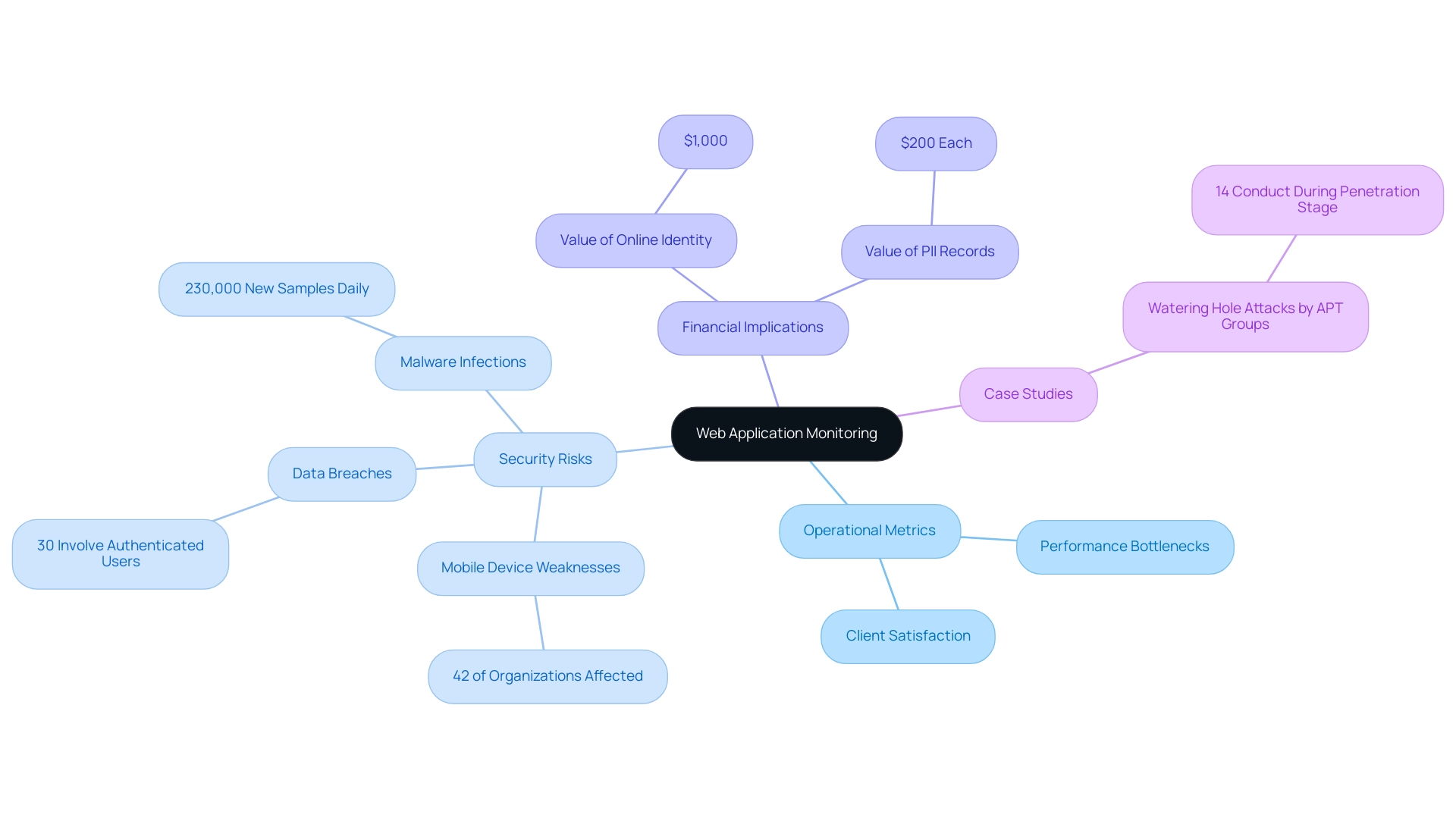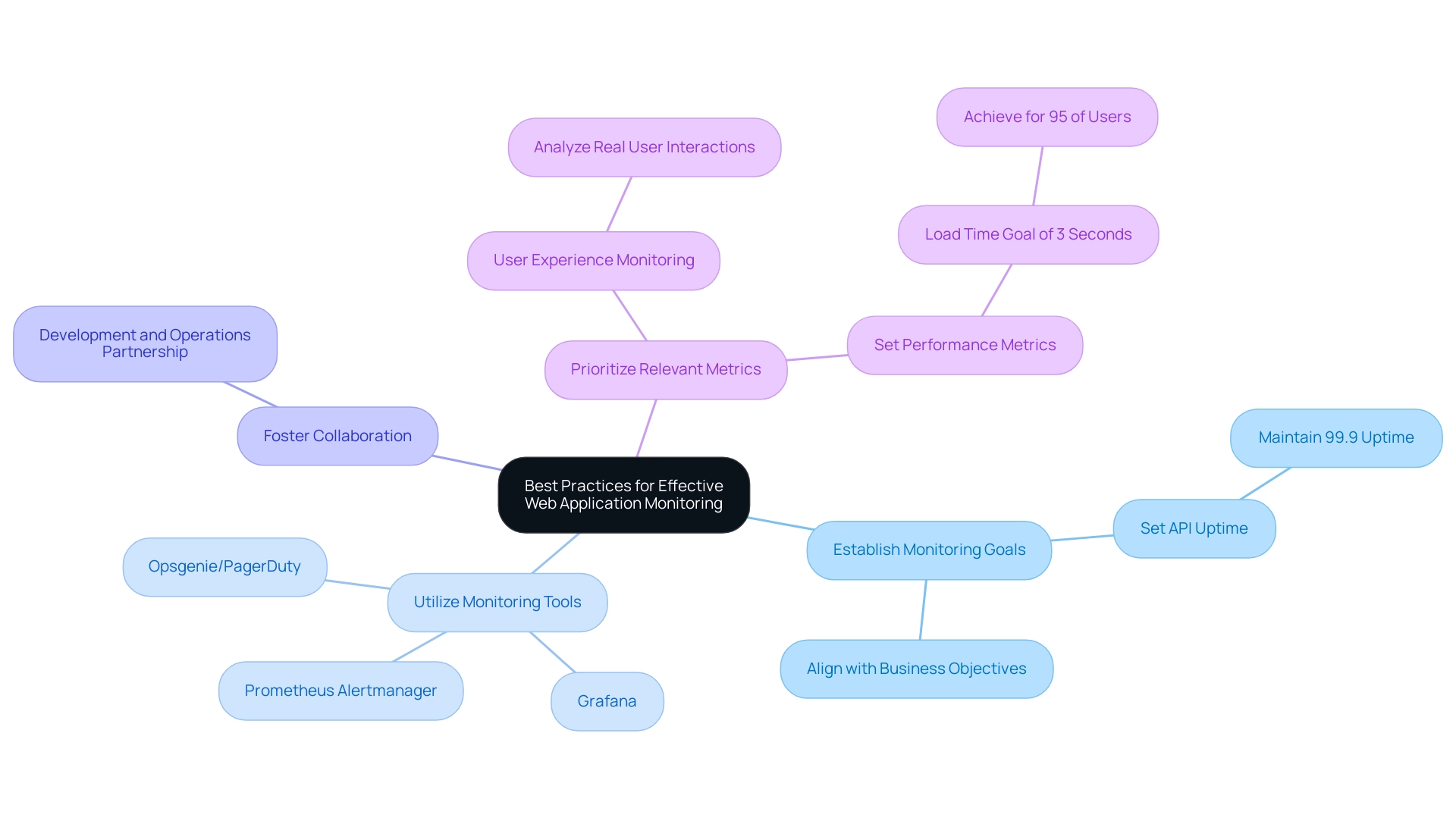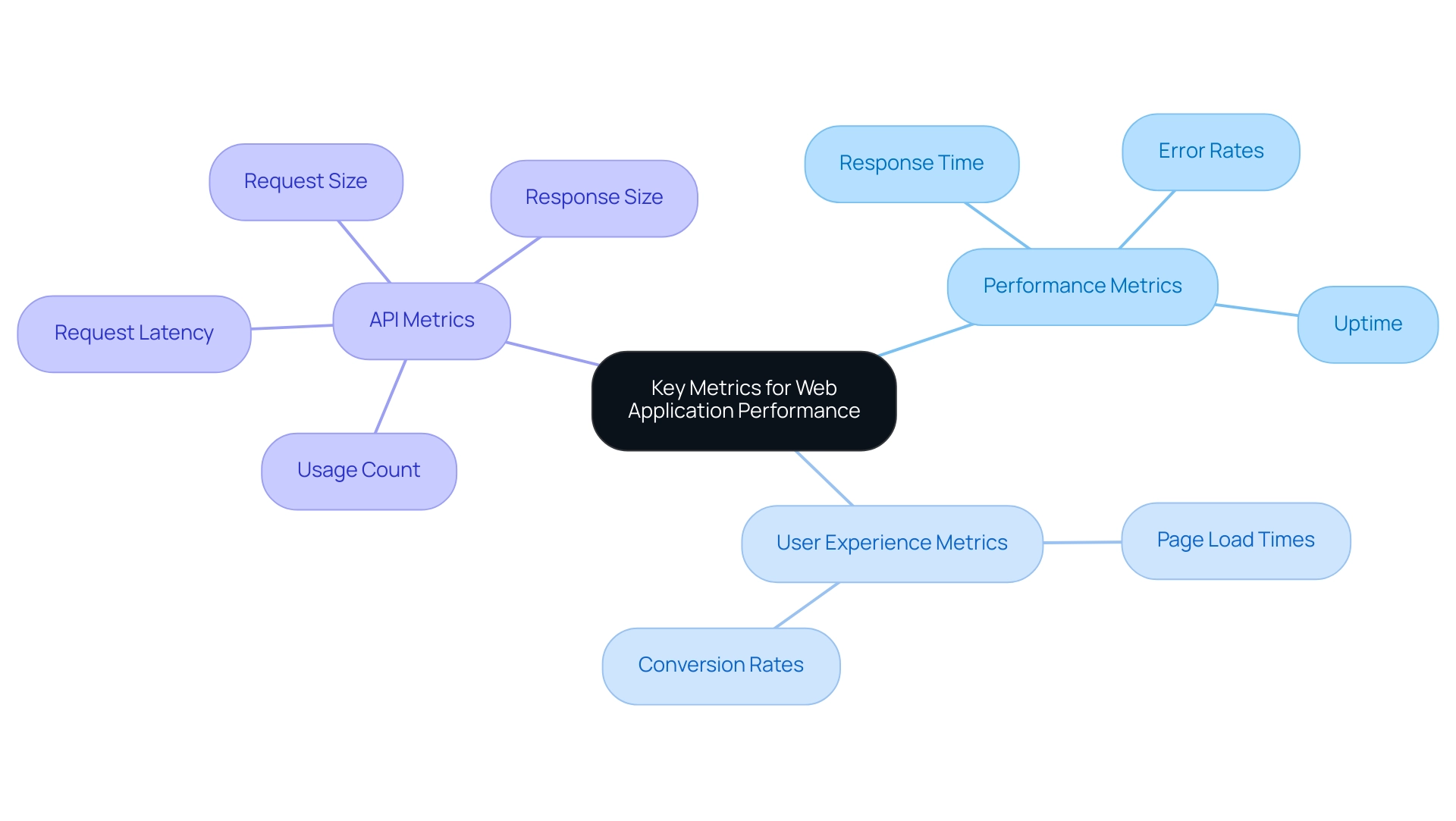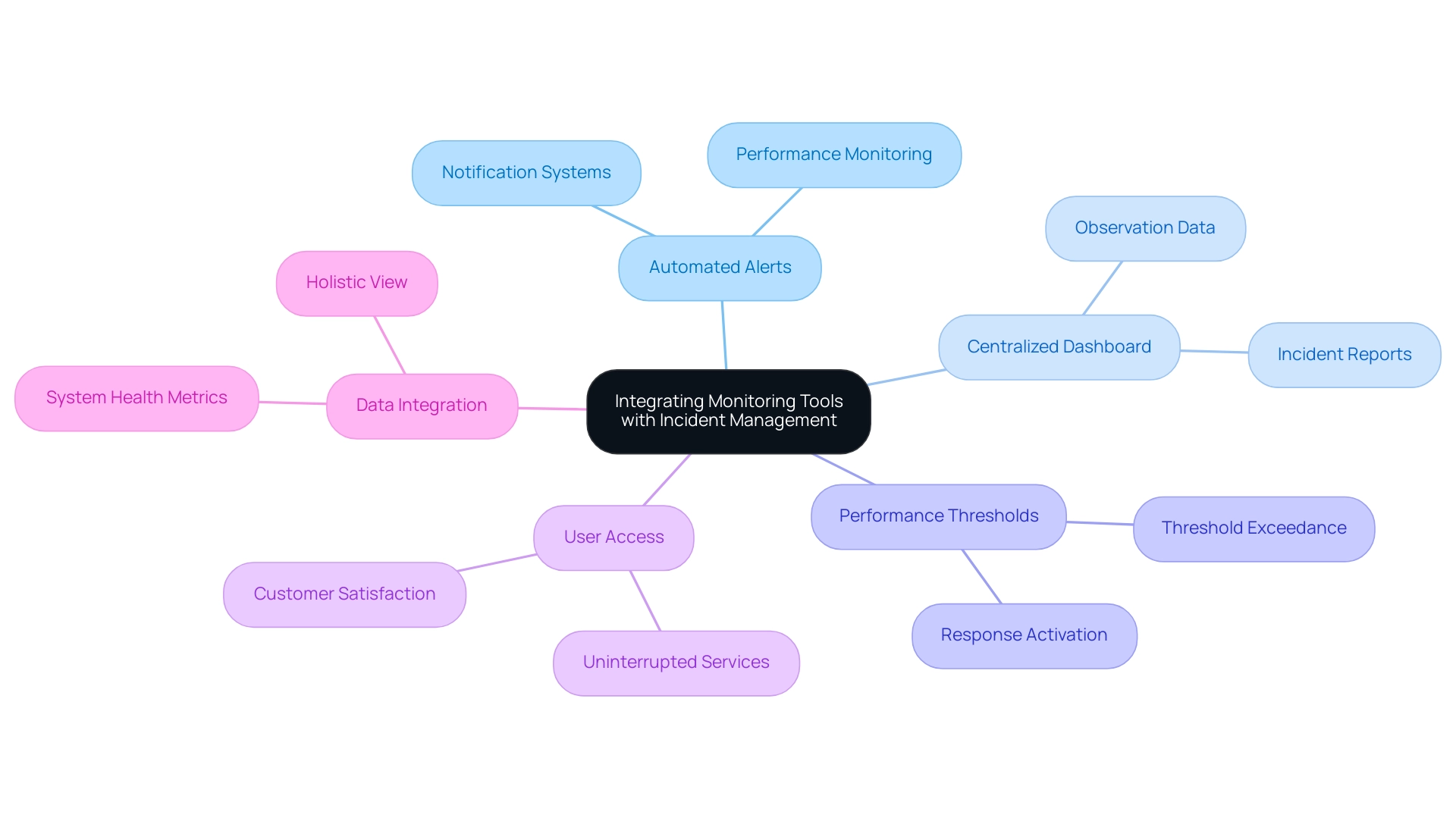Introduction
In the rapidly evolving digital landscape, the performance of web applications stands as a critical determinant of business success. As organizations strive to enhance user satisfaction and operational efficiency, the implementation of robust web application monitoring strategies has become indispensable.
By meticulously tracking performance metrics, businesses can swiftly identify and resolve issues that may hinder user experience, all while safeguarding against emerging security threats. With alarming statistics highlighting the prevalence of vulnerabilities and the financial ramifications of security incidents, the urgency for proactive monitoring is more pronounced than ever.
This article delves into the essential techniques of web application monitoring, best practices for implementation, key performance metrics to prioritize, and the integration of monitoring tools with incident management systems, equipping organizations with the insights needed to navigate the complexities of today's digital environment.
Understanding Web Application Monitoring: A Foundation for Success
In the current rapid digital landscape, web applications monitoring has become a crucial practice for ensuring optimal system functionality and improving client satisfaction. This process entails web applications monitoring through the careful observation of various operational metrics, allowing organizations to identify performance bottlenecks, detect downtime, and resolve experience issues effectively. Considering that our customized e-commerce solutions have a demonstrated history of improving essential KPIs like retention rates, Average Order Value (AOV), and Lifetime Value (LTV), the importance of proactive oversight is emphasized by concerning statistics:
- 42% of organizations have indicated that weaknesses in mobile devices and online platforms have led to security incidents.
- 30% of data breaches involve verified users, underscoring the vital need for vigilance.
Furthermore, with malware infections escalating dramatically—approximately 230,000 new samples are generated daily—the stakes have never been higher. For e-commerce businesses, where digital channels are pivotal for revenue generation and community engagement, implementing strong web applications monitoring strategies is critical. Such vigilance not only protects an organization’s online presence but also ensures effective web applications monitoring, keeping e-commerce platforms stable and responsive, ultimately driving higher customer satisfaction and loyalty.
The threat landscape is further illustrated by case studies, such as the 'Watering Hole Attacks by APT Groups,' which reveal how diverse strategies can compromise security during the penetration stage. Additionally, the financial implications of security incidents are significant:
- Access to someone's entire online identity is valued at approximately $1,000.
- PII records are worth about $200 each.
With over 20 years of experience in delivering tailored solutions that reshape industries, we understand the urgent need for businesses to adapt and enhance their digital strategies in response to emerging threats.
As we transition into 2024, the newest trends in web applications monitoring will keep evolving, mirroring this urgency.

Exploring Different Types of Web Application Monitoring Techniques
Web applications monitoring is crucial for sustaining optimal functionality, and it can be categorized into two main methods: synthetic tracking and real participant evaluation (RPE). Synthetic oversight employs automated tests to mimic user interactions, enabling businesses to detect possible efficiency issues in advance before they affect actual users. This method is particularly advantageous as it provides a controlled environment for testing, enabling teams to establish performance baselines and alert thresholds prior to deployment.
For instance, synthetic observation can be employed at every development stage, which helps detect latency and downtime early, thus preventing costly fixes after launch. This is particularly crucial since artificial oversight can efficiently detect problems before they impact individuals, resulting in substantial cost reductions for companies.
On the other hand, real participant tracking collects information from genuine individuals in real-time, providing valuable insights into authentic experiences and system performance. RUM is often more cost-effective, as it involves integrating a JavaScript tag and collecting data passively, which can reduce operational costs while still providing critical insights. By examining this data, businesses can comprehend how individuals engage with their software in the real world, uncovering areas for enhancement.
The real strength of web applications monitoring resides in the blend of these two methods. By combining insights from both synthetic monitoring and RUM, organizations can improve their web applications monitoring to accelerate troubleshooting processes and reproduce end-user issues more effectively. As highlighted in the case study titled "Benefits of Synthetic Monitoring," this method can be utilized at every stage of development, allowing for pre-production testing of websites and applications.
This assists in setting up benchmarks and alert limits prior to going live, allowing individuals to swiftly recognize latency and downtime, isolate issues, and avoid expensive retroactive corrections.
As Billy Hoffman, CTO at Rigor, emphasizes, "Following Rigor's acquisition by Splunk, I focus on improving and integrating capabilities across APM, RUM, and Synthetics products." This integration not only enhances the oversight framework but also significantly increases the likelihood of promptly identifying and resolving performance challenges, ultimately leading to a superior user experience.
![]()
Best Practices for Effective Web Application Monitoring
To ensure effective web applications monitoring, organizations must adopt several best practices that align with their strategic objectives. First and foremost, it is essential to establish clear monitoring goals that correlate with business objectives. This focus on web applications monitoring ensures that resources are directed toward what truly impacts performance.
For instance, aiming for a 99.9% API uptime in the upcoming quarter not only meets technical standards but also reinforces user trust in the software. Additionally, tools for web applications monitoring such as Prometheus Alertmanager, Grafana, and Opsgenie/PagerDuty should be meticulously configured to capture pertinent data while avoiding the pitfalls of overwhelming the system with extraneous information. Regularly reviewing and updating these configurations is crucial for web applications monitoring to adapt to the evolving landscape of the application and its operating environment.
Furthermore, fostering a collaborative culture between development and operations teams is vital. This partnership guarantees that insights obtained from web applications monitoring data are effectively utilized to promote ongoing enhancements. As Todd H. Gardner, CEO of Request Metrics, aptly puts it,
- Which success metric is most meaningful to you?
This question underscores the need for organizations to prioritize metrics that align with their core objectives. Furthermore, experience assessment plays a vital role by evaluating genuine interactions to improve software efficiency. For example, the case study titled 'Aligning Monitoring with Expectations' illustrates that setting a goal to achieve a load time of 3 seconds or less for 95% of individuals within six months can significantly enhance satisfaction and retention.
By incorporating these optimal methods, organizations can enhance experience oversight, ultimately resulting in better software functionality.

Key Metrics to Monitor for Optimal Web Application Performance
Efficient web applications monitoring of platform performance requires attention to several essential metrics that can greatly influence experience. Among these, response time is crucial, as it assesses the speed at which the software reacts to requests. Error rates are equally crucial; they capture the frequency of mistakes encountered by individuals, which directly affects satisfaction and trust.
Uptime, indicating the percentage of time the system remains operational, is another crucial metric that organizations must monitor to ensure reliability. Furthermore, tracking user interactions—such as page load times and conversion rates—provides invaluable insights into user experience dynamics. Developers should monitor 13 essential software efficiency metrics to gain a comprehensive view of their system's health.
As Joydip Kanjilal aptly states,
Capturing the right metrics will give you a comprehensive report and powerful insights into ways to improve your application.
Furthermore, API analysis and reporting are vital in app development, with specific KPIs such as:
- usage count
- request latency
- request size
- response size
that must be monitored for optimal results. By prioritizing these metrics, organizations can proactively identify efficiency bottlenecks and enhance user satisfaction.
For instance, case studies on dependency health indicate that monitoring essential dependencies can prevent disruptions and simplify troubleshooting, thereby ensuring continuous system operation and optimal functioning. As we enter 2024, comprehending the average response times for web applications monitoring and the related statistics will be crucial for developers aiming to enhance their evaluation strategies.

Integrating Monitoring Tools with Incident Management for Enhanced Response
To greatly enhance response times to operational challenges, organizations must strategically combine their tracking tools with incident management systems. This integration facilitates automated alerts that activate whenever performance thresholds are exceeded, guaranteeing that the relevant teams are notified without delay. A centralized dashboard that consolidates observation data alongside incident reports enhances communication and expedites response efforts.
This approach not only minimizes downtime but also ensures users maintain uninterrupted access to services, thereby safeguarding customer satisfaction and loyalty. Significantly, 3.2% of participants considered the 'Other' category helpful but are not presently employing it, emphasizing a gap in the effective use of assessment tools. As demonstrated in the case study 'Combining API Testing with Oversight,' organizations need prompt notifications when an API is slow or down, requiring a tool that integrates both oversight and testing capabilities.
This combination offers a comprehensive evaluation of application functionality, exemplified by Anypoint Functional Monitoring. As noted by research expert Alexandra Borgeaud, the fusion of web applications monitoring and incident management is increasingly vital in today's digital landscape. The urgent requirement for organizations to stay ahead in managing outcomes while keeping pace with the latest developments in incident management, particularly in the context of Ai's growing influence in cybersecurity, cannot be overstated.
Better visibility and decision-making are achieved through data integration, providing a holistic view of system health and performance metrics.

Conclusion
In the ever-evolving digital landscape, the importance of web application monitoring cannot be overstated. As explored throughout this article, implementing effective monitoring strategies is crucial for maintaining optimal performance and enhancing user satisfaction. By utilizing both synthetic monitoring and real user monitoring, organizations can proactively identify and address performance bottlenecks, ensuring that applications remain responsive and reliable under various conditions.
Adopting best practices in web application monitoring, such as:
- Setting clear goals
- Fostering collaboration between development and operations teams
Empowers businesses to align their monitoring efforts with overarching business objectives. Furthermore, prioritizing key performance metrics—including:
- Response time
- Error rates
- Uptime
Enables organizations to capture valuable insights into user experiences, facilitating continuous improvement and driving customer loyalty.
Integrating monitoring tools with incident management systems stands as a pivotal strategy for enhancing response times to performance issues. By ensuring that alerts are automated and data is centralized, organizations can minimize downtime and maintain uninterrupted service for users. As the digital landscape continues to evolve, the necessity for robust monitoring practices will only intensify, making it imperative for businesses to stay ahead of emerging security threats and performance challenges. Embracing these strategies will not only safeguard an organization’s online presence but also foster a culture of excellence in user experience, ultimately driving long-term success in an increasingly competitive environment.





